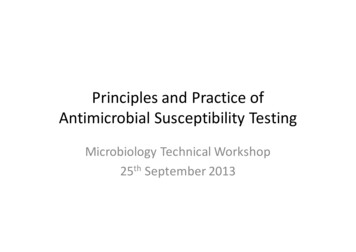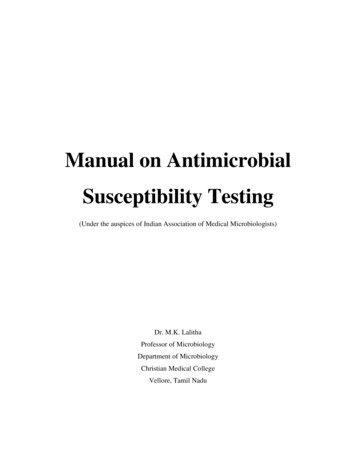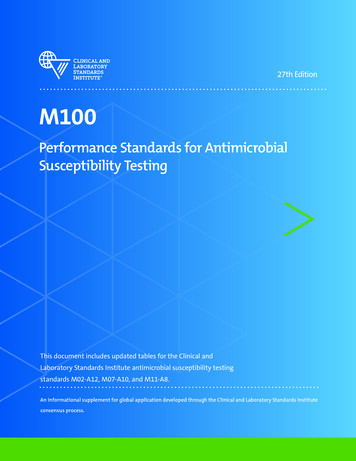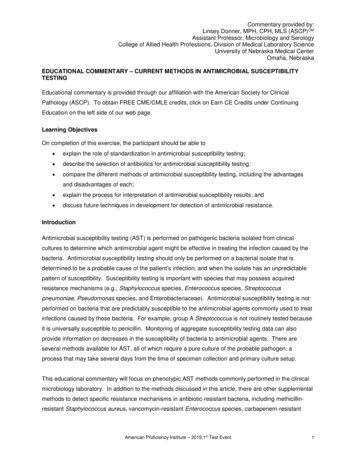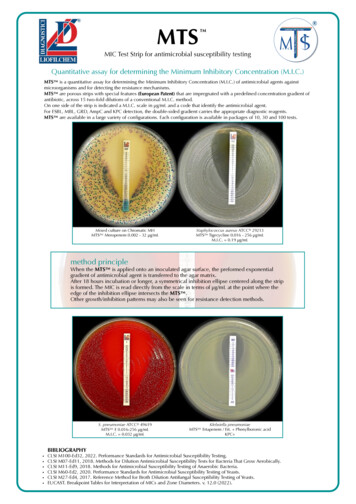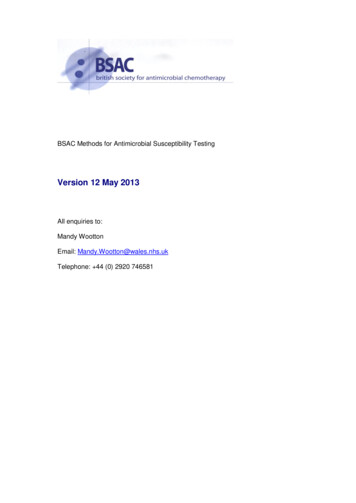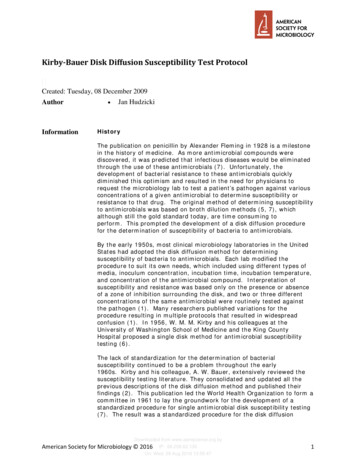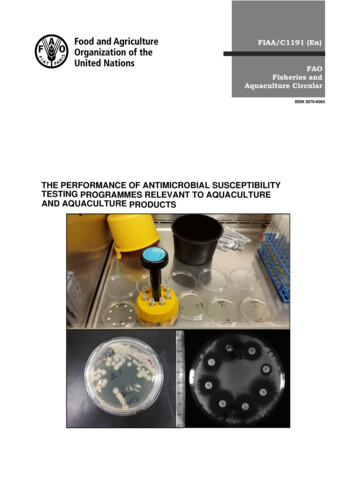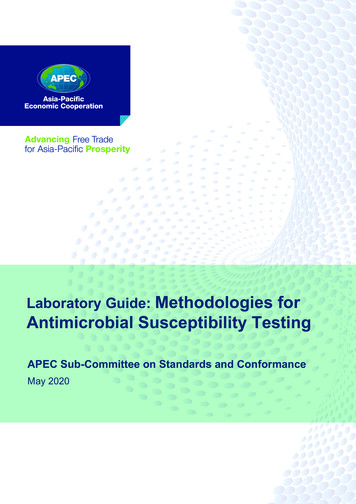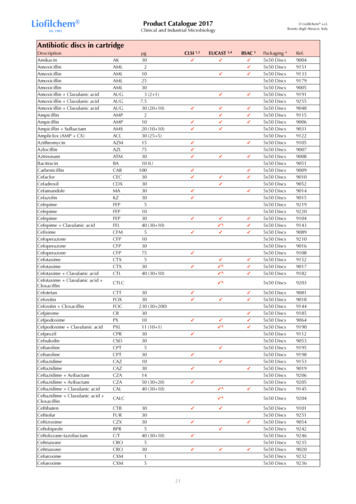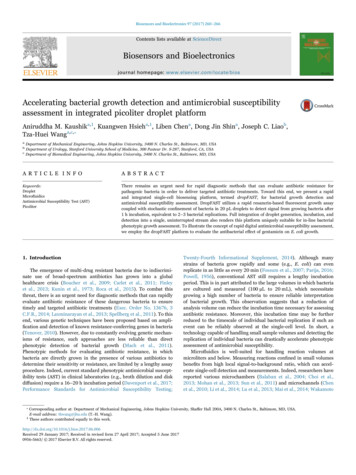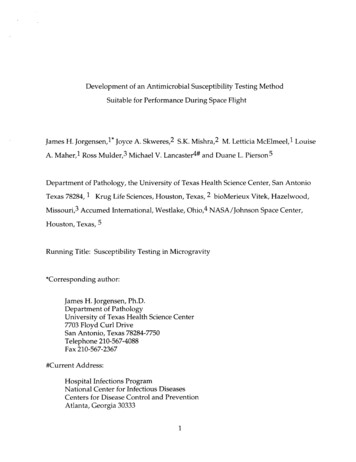
Transcription
Development of an Antimicrobial Susceptibility Testing MethodSuitable for Performance During SpaceFlightJamesH. Jorgensen,1. JoyceA. Skweres,2 S.K. Mishra, 2 M. Letticia McElmeel,1 LouiseA. Maher,1 RossMulder, 3 Michael V. Lancaster4# and Duane L. Pierson5Department of Pathology, the University of TexasHealth ScienceCenter, SanAntonioTexas 78284,1 Krug Life Sciences,Houston, Texas,2 bioMerieux Vitek, Hazelwood,Missouri, 3 Accumed International, Westlake, Ohio, 4 NASA/Johnson SpaceCenter,Houston, stingin Microgravityauthor:James H. Jorgensen,Ph.D.Departmentof PathologyUniversityof TexasHealthScienceCenter7703 Floyd Curl DriveSan Antonio,Texas 78284-7750Telephone210-567-4088Fax ionsProgramCenterfor InfectiousCentersfor ntion
NA A .-. I-Z12973ABSTRACTVeryspacelittleflightwasis knownuponundertakentestsduringcardsthea Spacedilutionslactamaseandactionto o storageschedule(normalgravity)proposedof the cardsthecardsTM,Aandbrothprioryieldedin-flightto launchaboardfor 18-48Ground-basedcardsastronauts'MIC valuesnegativeIn someformattemperatureof inoculatedandandTheastronauts.researcha standardon the groundincubationof theaeruginosa.mediaat refrigerationby the monasthe leaureus,(beta-lactamaseanda t -(alamarBluedemonstrateddeterminedof the Vitekthe mission'sindicatorhascloacae,initiation,MICscolito thoseof inoculatedof MICsreproducibleto bacterin somein the Vitekof rchcephalosporins,endpointsstudy6-11 es,OH).testto includetetracycline,of f a malby incorporationresultswereenvironmenton bacterialpreparederythromycin,by visualsusceptibility8ocfor conductingvancomycin,International,microgravitya simpleHazelwood,determinedof theagentstrimethoprim/sulfamethoxazole.werehavethe affectsof antimicrobialof 14 antimicrobialinhibitor,drugstheregardingwilloftheh priorstudiesfor 7 daysactivities.be generatedat 4Forby
ite.Thisinformationclassesandprocedureon theof antibiotics.incubationcan provideaffectsof a seconda safeof microgravityset of testandcompactcardsin a laboratoryexperimenton the biologicalthatactivitiesatshouldof
lcraftcurrentlySpacethe effectProjectsusceptibility7 spacecraftfromof 4,6,14).SpacewasE. coliwereindicatedreturnAgencytestedto normalanalysestheanderythromycinweremore(6,14).in a staticagainstthefiveS. acoliantibioticsthatthebywereMICsthanforin ground-D1 missionto a single(microgravitywasflightthe Salyutas indicatedIn this experiment,incubatorTestin ulturesconditions)in theandin-flighttestscontrols.of microorganismsmicrobes,of . coliflight-in bothapparentis knowntheteamin vitroto increase1 g. Increasedspace-grownlevelsthecolistinsimulatedto the ground-thatsaida second(1,10,13).testedin the spaceof bacteriaduringof solatesstudieslittleantimicrobialisolatesIn a 1985 experimentdemonstrateda centrifugecomparedagainstastronautsSpaceon theincludingby a French-Sovietchloramphenicol,twiceEarly(4). Relativelyincreasedthe Russianmissionson the susceptibilityfromof the cosmonautskanamycincontrolsperformedin 1982 (3,14).to be approximatelydurationthis decade.flightbaselinewaslongeraboardon microorganisms,recoveredResistance90 dayscell densitysomewhatwereonethe flight.effectsspaceto udieseventhanduringincreasedBacteriaas comparedduringdistinctandagents.in 1975isolatesratesandare plannedof microgravityantimicrobialof tstimeshaveon thethe resultsground,of theseofinas
initial experiments, the apparent increasein resistancedid not appear to be an acquiredcharacteristic of the organisms, but rather a temporary adaptation to conditions ofmicrogravity. Electron-microscopy of space-grown cultures have shown an increaseincell-wall thickness (3). This may have altered cellular permeability, thus affecting thepenetration of antibiotics into the cells. However, increased resistanceto temporarymodificationbe excluded.Thus,affectssomeis someor classesof cumed,duringcommonthatShuttleusesMO)for manualbothtest verselysignificancein theandinoculabe handledof this studyantimicrobialpathogens.liquidsfor susceptibilitysafelywasto be conductedpreparedof ythe useprecludecannotbacterialallowwithoutto designof currentA susceptibilityincorporatinga growthsusceptibilitydeterminationsaon an cards(alamarBlue M;by astronautsmission.A ATERIALSBacterialclinicaldo notThe purposeevaluateHazelwood,OH)flightor agarwouldagainstWestlake,a eduredevelopedcouldspacein cell physiologya microgravityprolongedtestingthatrelevanceof brothsafetysimple,whichto prepareor platesor rapeuticof ontainingtests,theredrugseventualityof molecularto antibioticsEscherichiaANDof coli ,pathogensutilizedconsistingin theseA inosaof
ATCC 27853,KlebsiellaselectedbecauseAntimicrobialof knownagentsinclusionin orated30 wellin ainedampicillin,amoxicillinin a fixed1-32 sreadingstesttg/ml0.06-8(basedtestfor eachorganismVitekcardsmediatg/ml,or grouppossible,on thespecies,4-128and0.06-16trimethoprimcards(based3 and4on tedandas indicateda redoxof a2-64 tg/mlon the g/ml;0.004-0.12media.of theg/ml;negativein standardantibioticon eithertg/mlcardsmediumcephalothin0.06-162:1 ratio);ciprofloxacin,0.06-2formulatedin a fixedThefor -32 tg/ml;dilutions0.25-16For gramgrowthlag/ml;ciprofloxacin,1:19 ratio).synthesissusceptibilityVitek.of each2 ;inhibitor,researchwithouttwo1 andaction.proteingyraseby antibioticsof approximatelytest methoxazole.for this studyThea rangefor eachg/ml;cards.becauseforof antimicrobiala f theutilityand(combinedandprovidedVitekto illins,metabolismlog2 dilutionsclearagentsclavulanatethe folatewereclassesof the strainsstudyagentsclinicalchemicalSeveralto sactivecloacae.or resistanceon theirinhibitorandEnterobacterfor study.of differenttetracycline,ciprofloxacin;makebasedthe cell wallthe torbasedIn ordertoon
(alamarBlueTMAccumed,U.S. dindicatorturnedfromdefinea suitableorganism.(Difco)A lecardsStoragestandardat 35 Ccarddaysthepriorfor 16-20at 4-8 Cinoculatedto incubation.chosenof thethencards.eitherfor a definedwereIn otheror at roominoculumwithtestsuspensioninFor gram-positivesuspensionwasin 1.8 ml of testcardsdensityusingmedium.a Vitekin each50 1wellvacuumof thefilledx 105 CFU/ml.thencardsfinalandFor gram-negatives,placedto fill the VitekThe1-3andused(Becton-for the bacterialbacterialabove.resazurin).filled0.5 imentswasfinala freshwasBrothfor thesetotest mediumDetroit,simultaneouslyas thethetestto 0.0045%resazurin)weretest mediumsuspensionof the Vitekholderhourscards(in saline)manner.approximatelyor storedexperiments,usualwasto 0.003%test mediumwereincubationVitekincubatorsevenin sitiveto a 0.5 McFarlandof the McFarlandinoculatedBBL Sceptorby first preparingin turbidityspecialTMwhenfor eachLaboratories,[nowmedium.wereP. aeruginosa,(DifcoalamarBlueVitektheaccomplishedto 1.8 ml of thefillingThe100 tl of a 1:10 dilutionof a 1:10 rationbrothSparks,Biosciencesinto eachto be visuallyindicator(equivalentTMby AlamarPreliminaryE. faecalis,by ceaetriplealamarBlueof thewasMueller-HintonandFor Groupaddedandadjustedprovidedof a test organismto brighttest mediumof cationextract0.45%growthbluekindlyOhio])For the staphylococci,consistedyeastno. 5,501,959;Theinoculatedplacedperiodstoredin a standardpriorunderexperiments,temperaturewere35 Cto incubation.refrigerationVitekfor 48 hours.7cardscardsplacedin abacteriologicIn mostfor approximatelywereincubatedeither
DeterminationindividualwellsIf growthbrightof MlCsoccurredpink,antibioticspeciallyin theandthe specialexaminedindicatinglack of growthto thatwereusingvisuallypresencedesignedfor a changeto thechangedata sheetwhichof the cards,of the representedbluetoConversely,indicatedby markingtheindicator.at that test concentration.(i.e., remainingThe data wereincubationin colortheantibioticof a wellconcentration.Followingof an pinkthe configurationwellon aof thatcard.Determinationclinicalof referenceorigin,microdilutionStandardstheMICsof the studyprocedure(NCCLS)non-fastidious(7).brothwasof susceptibilityreadingsof the specialfor rminedhorseincludedresultsA Streptococcusin this isolateofto the brothbrothblood-supplementedcomparedisolatesfor ClinicalMueller-HintonThe MIC resultswerecultureaccordingCommitteeadjustedfor the Groupresults.Vitekcontrolcation3% lysedusedwereFor the stockby the edforadjusted(7).usingmanualto the NCCLS(7), or to NCCLSexpectedreferencerangesbrothon the test isolates.RESULTSUsea growthRelativelygrowthof theindicatorenriched,of theBecausereadtheresultsconfiguredVitekMICsto be iallyof theandclarityrecordedcardstest mediasharplydefinedanddeterminedweregrowthof the visualindicatoron the specialreportcard.8incorporationusedwithoutin orderend-pointssystem,sheetsof alamarBlueasdifficulty.to providewitheachTMtheVitekin less thanrapidindicatorcardcould30 secondsperbe
Preliminarystoredat 4 Cadverselyorderthestudiesfor sevenaffectingto theNCCLSdeterminedMICsby suefrommethodsat 4 Cantimicrobialtendedto be higherwhenat aThistoflight.in the specialusing35octo eightagent-organismcontrolandthefor sevenrange,Theor thatweretrimethoprim/in the rencecardsinmodule.determinedMIC values.NCCLStakento launchandMICsthe NCCLShigherpriorandwithoutwasincubatedtest cardstestprocedureapproachwouldof NCCLSoutsideh at 35 dthenof the inoculatedtherebe inoculatedon the groundinoculateby usein MICswereThisa dby storagethatthannot depicted).concernscouldfor 16-18temperature,safetydetermined1-2).to incubationusinggoodtest cardsin a rior(datathe missiondifficultieswasthe Vitekat refrigeratedinoculumTheredaysto be inoculatedduringthethattest resultsstoredtimeavoidor eightthecardsindicatedcardsthanthe dthanincubationthatthe referencethe (Tablesa preciseof the study.cefuroximethanwerevaluespreventedin this partandthatof the Vitek(e.g.,4).In someand25922).roomat 35 C (Tablestherethe o the conventionalof the nderalsocomparable3 andE. coli ATCCvaluescardsoften,wereof some35oca numberof thecardMICswithS. aureustheVitekincubation,agentswerecardof off-lowerATCCMICsas comparedwerewith
DISCUSSIONThe risk of infectious diseasesis increasedduring spaceflight becauseof the crewworking and living in crowded conditions, the useof reclaimed/recycled air and water,the absenceof infection isolation facilities, as well as human physiological changes insuch an environment (1,8,9). In addition, the observed attenuation of the humanimmune responsereported by American, Russian, and other international investigatorsmay be the most obvious reason for an increasedrisk of infectious diseasesduringspaceflight (2,5,12). The dosageof antibiotics for infections that develop in spacemaybe affected by alterations in the absorption rates and the pharmacokinetics andpharmacodynamics of antibiotics that have been demonstrated during spaceflight (11).Any decreasein microbial susceptibility to antibiotics during spaceflight couldmarkedly influence decisions on the management of infectious diseasesthat mightdevelop during long-duration missions. Severalprevious studies, although limited inscope,suggestthat bacteria cultivated in microgravity may show increased resistancetocertain antibiotics (3,4,6,10,13,14).The methodology described in this report would allow simple determinations ofthe antimicrobial susceptibility of several bacterial speciesto be made by astronautsduring a SpaceShuttle mission. The color end point method of defining MICs canprovide on-board measurementsof susceptibility during the prolonged period ofmicrogravity that occurs during a shuttle flight. The feasibility of incubating the testcards at ambient room temperature was demonstrated in this study in the event that35 Cincubation could not be provided on board the SpaceShuttle.The MICs recorded in this ground-based pilot study were reproducible andsometimes encompassedwithin the NCCLS referenceranges with four ATCC controlstrains commonly used in clinical laboratory susceptibility determinations. However,some MIC values were higher when determined in the Vitek cards. Elevated10
trimethoprim/sulfamethoxazoleMICs likely were the result of excessthymidinecontributed by the yeast extract added to the Mueller-Hinton broth to promote rapid,luxuriant growth of the test organisms. The tendency for higher gentamicin,erythromycin, tetracycline, and ciprofloxacin MICs in the special Vitek cards, may havebeen the result of a decreasein pH of the test media during prolonged storage of theinoculated cards at 4 Cprior to the period of incubation. Future experiments willinclude periodic pH measurements to assuremaintenance of the proper medium pHduring the pre-incubation period. Despite some deviations from the standard referencevalues, the MICs determined in the special Vitek cards were quite reproducible, andshould allow recognition of any significant increaseor decreasein susceptibility thatmight occur during the microgravity incubation period as compared to thesimultaneously inoculated and incubated ground-based control card MICs. In order toincrease the statistical confidence of the MIC results determined in the test system bythe astronauts and the ground-based laboratory staff, eachorganism will be tested intriplicate in a blinded fashion.The goal of this proposed SpaceShuttle experiment using the susceptibilityprocedures described herein is to confirm or refute those earlier reports of increasedresistanceby examining strains representing a wider spectrum of clinically significantspeciesand to examine antibiotics of every clinically relevant classand mechanism ofaction.The susceptibility testing methodology described in this report (special Vitekcards and color growth indicator system)has been developed to facilitate simple, fast,and safe handling and reading by the SpaceShuttle crew with minimal crew timerequired for the experiment. The authors are hopeful that the final version of thisexperiment will be scheduled for a SpaceShuttle mission in the near future. The resultsof that experiment should clarify whether there is any adverse effect of microgravity onthe activities of antimicrobial agentsof various classesagainst commonly encounteredbacterial pathogens.11
REFERENCES1.Ferguson,J. K., G.R.Investigations.Apollo.andIn: changesOffice,duringL., N. Moatti,1986.Antibioticactivity4.Mishra,J., ed.Rykova,G.in space.S. K., ation,andClin.1992.E.A.J. ronauticslong-durationLapchine,1975.ofScientificp. 83-103.I. V., M.P.3.Lederberg,and B.J. Mieszkuc.R. S., L.F. of Microbiology.Antropova.Biol.1993.54:189-201.J. Templier,andR. Tixador.12:933-938.flighteffectsSan Diego,on microoganisms.CA: AcademicIn:Press,14:53-60.5.Mishra,S. K., E. Segal,Pierson,H. Sandovsky-Losica,MycoticDiseases.Moatti,1986.J. Med.E. Gunter,andPreliminaryresultsD.A.Vet. Mycol.N., L. li,Immunity,D.L.and32:379-406.G. Gasset,of theKurup,"antibio"G.Richoilley,experiment.J. Templier,andR. Tixador.Naturwissenschaften73: andardM7-A3.for estsStandards.for bacteriafor Clinical1993.that Y. G., V.M.Shilov,and immunologicaland SpaceResearch.I.V. Konstantinova,and S.N.aspectsmannedof extended9:11-16.12Zaloguyev.spaceflight.1971.Life
9.Pierson,D. L., V.J. Bassinger,Cioletti,and25 tute11.NewPutcha,L., andYorkIn:Meeting.Taylor,Leukocute13.andBiol.of blication1994.eds.L.A.fromNo. 932139.MicrobiologicalFoundationsof harmacokineticLanger,andF. Theeuwes,618. ProceedingsNY. onsequencesof theeds.TemporalofAnnalsof theControlof .A. F., sian,TechnicalSupportE. Gunter,and postflightandF. M., andII: ghtof AeronauticsSulzman,of 3.D. L., M.R.Contamination.andMishra.T.C. onin space.StudyG.of minimumAviat.TestandSpaceProjectof U.S. ificandp. 69-81.R., G. t,J. Med.56:748-751.Bes,N.Moatti,of antibioticsL.on bacteria
Table 1. MICs determined using special Vitek cards on NCCLS-ATCC control strainsfollowing storage for 7-8 days at 4 C, then incubation for 16-18h at 35 C.S. aureusATCC29213MIC(n)mode( fa770.540.51-40.12-0.5 .06-0.25MIC(n)mode0.25-1RangepenicillinE. faecalis1% within57( tg/ml)rangeNCCLSrange% thin77 2 0.5 2 741-4100trim/sulfaciprofloxacin77164 0.50.25-2029E. coliATCC41001000.12-0.50.12-0.5259222-416- 162-4MIC(n)mode(pg/ml)rangeNCCLSrange% 250.25ciprofloxacin60.030.03N.D. Couldnot be determinedbased0.12-0.251-24on concentrations14tested.0.06-0.50.25-11-4 0.50.004-0.015100100501001000
E. coliATCC35218MIC(n)mode( g/ml)rangebrothmicrodilution% within 1 dilampicillin7 32 32 64amox/clavcephalothin7716168-1616-324 16 a16100 .543100ciprofloxacin70.030.03 0.25P. aeruginosaATCC278530.12-0.25MIC(n)modeNCCLSrange77 32 64 32 64cephalothin7 128 128cefuroximeceftazidime77 82 82gentamicin744tetracyclinetrim/sulfa77 32 2 32 2ciprofloxacin7 0.12 0.12N.D. CouldNCCLS6 % withinnotbe determinedapprovedrangeNCCLSapprovedbasedon ox/clavN.D.tested.% 320N.D.0.25-1N.D.
Table 2. MICs determined using special Vitek cards on strains of clinical originfollowing storage for 7-8 days at 4 C, then incubated for 16-18h at 35 C.Group AStreptococcus2726MIC ( alothinvancomycin770.030.50.030.5 0.250.25100100erythromycintrim / sulfa77 0.06 0.25 0.06 0.25-20.06 210043ciprofloxacin70.250K. pneumoniae12588MIC(n)mode 0.015 0.125 1 dilpenicillinoxacillin10.016 0.03-0.06% within100100( g/ml)brothrangemicrodilution% within 1 dilampicillinamox/clav66 3264 66 1282,40.5 1282-40.5 ulfa664,80.254-80.251 0.250100ciprofloxacin60.030.03 0.25N.D.E. on% within 1 dilampicillinamox/clav66 3264 3264- 6416N.T.0N.D.cephalothincefuroxime66 1284 1284-8 -40.583tetracycline688410016
trim/sulfaciprofloxacinN.D. CouldN.T. Not66not be determined0.250.03basedon concentrationstested.170.250.03-0.06tested.N T. 0.25
Table 3. MICs determined using special Vitek cards on NCCLS ATCC control strainsfollowing storage for 7-8 days at 4 C, then incubated for 48 h at room temperature.S. 60.25,110.25-10.25-1 0.50.12-0.550E. faecalisATCC0.5% within29212MIC(n)mode050( tg/ml)rangeNCCLSrange% withinNCCLSRangepenicillinoxacillin12124 24 21-48-32100N.D.cephalothin12 0.5 0.58-32N.D.vancomycinerythromycintrim/sulfa1212122 1616216- 168- 161-41-4 0.510000ciprofloxacin1240.25-20E. coliATCC425922MIC(n)mode( tg/ml)rangeNCCLSrange% 8cephalothincefuroxime99 42 .50.25-11-478ciprofloxacin90.0080.008N.D. Couldnot be determinedbasedon concentrations180.12-0.254tested. 0.50.004-0.0150100100
E. tion% within 1 dilampicillin9 32 32 64amox/clav988-164-16 a100 bcephalothincefuroxime9981 4-32 yclinetrim/sulfa9981ciprofloxacin9P. aeruginosaATCC0.01627853 0.06-0.121-4 1-8 0.06-1(n)mode0.250.5 0.25NCCLSrange99 32 64 32 64cephalothin9 128 1281178N.D.(lag/ml)rangeampicillinamox/clav2220.5 0.004-0.016MICN.D.% withinNCCLSRangeN.D.N.D.-N.D.N.D.cefuroxime9 8 8-ceftazidime9221-4100gentamicintetracycline994 324 320.5-28-3200trim/sulfa9 2 28-32N.D.ciprofloxacin9 0.12 0.120.25-1N.D.N.D. Couldnotbe determineda NCCLSapprovedrangeb% withinNCCLSapprovedbasedon concentrationsrange19tested.
Table 4. MICs determined using special Vitek cards on strains of clinical originfollowing storage for 7-8 days at 4 C, then incubated for 48 h at room temperature.Group dilutionpenicillinoxacillin12120.008 0.030.008-0.0160.03-0.060.015% within 1 dil100 0.12N.D 0.25 0.25N.D.100cephalothin120.015vancomycin120.25 0.008-0.015 0.12-0.25erythromycintrim/sulfa1212 0.06 0.25 0.06 0.06100- 0.25-0.5 20ciprofloxacin120.5-1- 0.2558K. x/clav1212 32 64 32 6432N.T.100N.D.cephalothincefuroxime1212 1284 1284-8 0.5,167tetracyclinetrim / sulfa121280.54- 320.25-0.51 0.250100ciprofloxacin120.030.03-0.060.25N.D.E. cloacae2596MICbrothmicrodilution% within 1 dil(gg/ml)(n)moderangeampicillinamox/clav1212 32 64 32 6416N.T.0N.D.cephalothincefuroxime1212 1288 1288- 8 2-40.50tetracycline1288- 3245020brothmicrodilution% within 1 dil
06N.D. Could not be determined based on concentrations tested.N.T. Not tested21N T 0.25
Development of an Antimicrobial Susceptibility Testing Method Suitable for PerformanceDuring SpaceFlight JamesH. Jorgensen,1.JoyceA. Skweres,2 S.K.Mishra,2 M. Letticia McElmeel,1Louise A. Maher,1RossMulder, 3Michael V. Lancaster4#and Duane L. Pierson5 Department of Patholog
